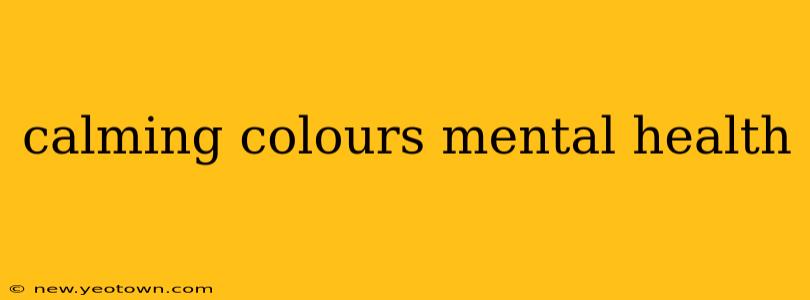We've all experienced the power of a beautiful sunset, the tranquility of a clear blue sky, or the comforting embrace of a cozy green space. These experiences aren't just aesthetically pleasing; they're deeply connected to our mental well-being. The colors surrounding us significantly influence our mood, energy levels, and even our physiological responses. This exploration delves into the world of calming colors and their remarkable impact on mental health.
Imagine stepping into a room painted a soft, tranquil blue. Or envision yourself surrounded by the gentle hues of a lavender field. These scenes evoke feelings of serenity and peace, and that's no accident. The relationship between color and mood is a fascinating area of study, with compelling evidence showing how certain colors can promote relaxation, reduce stress, and even improve sleep.
What are Calming Colors?
Calming colors are generally those associated with nature, peace, and relaxation. These hues tend to fall within the cooler end of the color spectrum, although some warmer tones can also contribute to a sense of calm. The most commonly cited calming colors include:
-
Blues: Often associated with the sky and ocean, blues evoke feelings of tranquility, peace, and security. They can lower heart rate and blood pressure, promoting relaxation.
-
Greens: Representing nature and growth, greens are calming and restorative. They promote a sense of balance and harmony, reducing stress and anxiety.
-
Purples/Lavenders: These colors combine the calming qualities of blue with the creativity of red, resulting in a soothing yet uplifting effect. They're often associated with serenity, luxury, and spirituality.
-
Soft Neutrals (Whites, Creams, Greys): While not strictly "colors," these neutrals provide a clean, uncluttered backdrop that allows for a sense of calm and spaciousness.
How Do Calming Colors Affect Mental Health?
The impact of calming colors on mental health is multifaceted:
-
Reduced Stress and Anxiety: Studies have shown that exposure to calming colors can help lower cortisol levels (the stress hormone), reducing feelings of anxiety and promoting relaxation.
-
Improved Sleep: Soft blues and greens in the bedroom can create a more conducive environment for restful sleep.
-
Enhanced Mood: Surrounding yourself with calming colors can uplift your mood, combating feelings of sadness or depression.
-
Increased Focus and Concentration: A calming environment can improve concentration and reduce mental fatigue.
What Colors Should I Avoid If I'm Trying to Improve My Mental Well-being?
While calming colors promote relaxation, certain colors can have the opposite effect. Bright, intense colors like reds and oranges, while energizing, can also be stimulating and even overwhelming for some individuals, potentially increasing feelings of anxiety or agitation. It's important to find a balance that works best for you.
Can Color Therapy Help with Mental Health Conditions?
Color therapy, also known as chromotherapy, is an alternative therapy that uses color to improve physical and mental well-being. While more research is needed to definitively establish its efficacy, anecdotal evidence and some studies suggest that color therapy can be a helpful complementary treatment for certain mental health conditions, particularly when combined with other therapies. It is crucial to consult with a mental health professional before relying solely on color therapy for a serious condition.
How Can I Incorporate Calming Colors into My Life?
Incorporating calming colors into your daily life is easier than you might think. Here are a few ideas:
-
Redecorate your home: Paint your walls, choose calming colored bedding, or add some calming colored cushions.
-
Wear calming colored clothing: Choose clothing in shades of blue, green, or lavender.
-
Spend time in nature: Surrounding yourself with natural environments, rich in calming colors, is a powerful way to improve your mental well-being.
-
Use calming colored accessories: Add a calming colored blanket or vase to your living space.
The power of color is undeniable. By strategically incorporating calming colors into our environment, we can create spaces that promote relaxation, reduce stress, and enhance our overall mental well-being. Remember, creating a calming environment is a personal journey. Experiment with different colors and find what works best for you. The right palette can be a significant step towards a more peaceful and balanced life.

